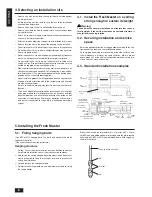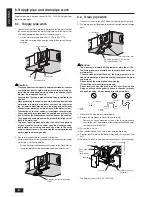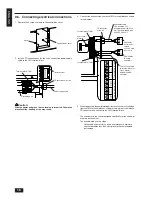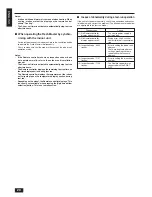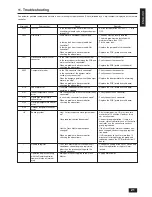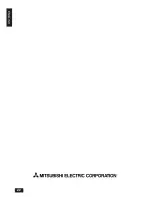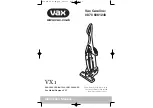
9
ENGLISH
7. Refrigerant pipe work
7.1. Refrigerant pipe specifications
To avoid dew drops, provide sufficient insulation to the refrigerant and
drain pipes.
When using commercially available refrigerant pipes, be sure to use
commercially available insulation (with a heat-resisting temperature of
more than 100°C and thickness given below) onto both liquid and gas
pipes.
Be also sure to use commercially available insulating material (with a
formed polyethylene’s specific gravity of 0.03 and thickness given be-
low) onto all pipes which pass through rooms.
1
Select the thickness of insulating material by pipe size.
Pipe size
Insulating material’s thickness
6.4 mm to 25.4 mm
More than 12 mm
28.6 mm to 38.1 mm
More than 15 mm
2
If the unit is used on the highest story of a building and under con-
ditions of high temperature and humidity, it is necessary to use
pipe size and insulating material’s thickness more than those given
in the table above.
3
If there are customer’s specifications, simply follow them.
4
Refrigerant pipe specifications
Model
GUF-50RDH3
GUF-100RDH3
Item
GUF-50RD3
GUF-100RD3
Liquid pipe
ø6.35
ø9.52
Gas pipe
ø12.7
ø15.88
5
Torque specifications
Outerdia of copper pipe
Tightening torque
ø6.35
14 ~ 18 N
•
m
ø9.52
34 ~ 42 N
•
m
ø12.7
49 ~ 61 N
•
m
ø15.88
68 ~ 82 N
•
m
6
Refrigerant system diagram
Refrigerant pipe
(Flare connection)
7.2. Refrigerant piping work
This piping work must be done in accordance with the installation manu-
als for both outdoor unit and BC controller (simultaneous cooling and
heating series R2).
•
With R2 systems connect Fresh Masters to BC controllers.
•
For constraints on pipe length and allowable difference of eleva-
tion, refer to the outdoor unit manual.
•
The method of pipe connection is flare connection.
Cautions On Refrigerant Piping
s
Be sure to use non-oxidative brazing for brazing to ensure
that no foreign matter or moisture enter into the pipe.
s
Be sure to apply refrigerating machine oil over the flare con-
nection seating surface and tighten the connection using a
double spanner.
s
Provide a metal brace to support the refrigerant pipe so that
no load is imparted to the Fresh Master end pipe. This metal
brace should be provided 50 cm away from the Fresh Master’s
flare connection.
Warning:
When installing and moving the unit, do not charge
it with refrigerant other than the refrigerant (R410A
R407C or R22) specified on the unit.
-
Mixing of a different refrigerant, air, etc. may cause the refrigerant
cycle to malfunction and result in severe damage.
Caution:
•
Use refrigerant piping made of C1220 (CU-DHP) phosphorus
deoxidized copper as specified in the JIS H3300 “Copper and
copper alloy seamless pipes and tubes”. In addition, be sure
that the inner and outer surfaces of the pipes are clean and
free of hazardous sulphur, oxides, dust/dirt, shaving particles,
oils, moisture, or any other contaminant.
•
Never use existing refrigerant piping.
-
The large amount of chlorine in conventional refrigerant and
refrigerator oil in the existing piping will cause the new refriger-
ant to deteriorate.
•
Store the piping to be used during installation indoors and
keep both ends of the piping sealed until just before brazing.
-
If dust, dirt, or water gets into the refrigerant cycle, the oil will
deteriorate and the compressor may fail.
•
Use Suniso 4GS or 3GS (small amount) refrigerator oil to coat
the flare and flange connection part. (For using R22)
•
Use ester oil, ether oil or alkylbenzene (small amount) as the
refrigerator oil to coat flares and flange connections. (For us-
ing R407C, R410A)
-
The refrigerant used in the unit is highly hygroscopic and mixes
with water and will degrade the refrigerator oil.
Gas pipe thermistor TH3
Liquid pipe thermistor TH2
Strainer
Flare
connection
Heat exchanger
Strainer
Linear expansion valve
Summary of Contents for Fresh Master GUF-100RD3
Page 22: ...22 ENGLISH ...






